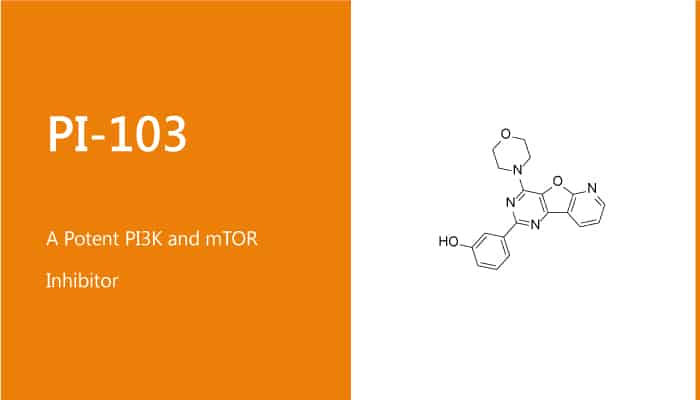The phosphatidylinositide 3-kinase family possesses 15 members. those members consist of four distinct classes as a basis on their structure and biological properties.
As we all know, this highly conserved family of enzymes involves various aspects of cellular homeostasis and exists a decline in a number of pathophysiologic conditions.
In this article, we will introduce a novel synthetic lead compound of the tricyclic pyridofuropyrimidine class, PI-103.
Firstly, in vitro, in a panel of human cancer cell lines, PI-103 exhibits potent antiproliferative properties. In addition, PI-103 inhibits leukemic proliferation, the clonogenicity of leukemic progenitors. At the same time, PI-103 induces mitochondrial apoptosis, especially in the compartment containing leukemic stem cells. Besides, PI-103 can potently inhibit rapamycin-sensitive or insensitive complexes of the protein kinase mTOR. It shows IC50 values of 20 nM and 83 nM for mTORC1 and mTORC2, respectively.

In female BALB/c mice. PI-103 treatment with 2.5 mg/kg exhibits a high volume of distribution at steady state (Vss = 0.0516 L). The liver to plasma ratio is 1.3 versus 0.7 for kidney and spleen. PI103 clears from plasma with a rate of 0.19 L/h.
When PI103 treatment with 50 mg/kg by intraperitoneal injection. There suggests an apparent clearance that is is similar to that following intravenous injection dosing (0.12 L/h).
In mice bearing U87MG glioblastoma xenografts, PI-103 results in 20-fold more glucuronide than parent compound in plasma. At a dose of 100 mg/kg, PI103 can decrease a reproducible and significant drop in phosphorylation of AKT on Ser473 15 min to 2 h after dosing. The ratio of p-AKT Ser473/total AKT can reach a nadir and returns to control levels by 4 h. PI-103 shows a therapeutic activity at well-tolerated doses in a number of human tumor models.
In conclusion, PI-103 is a potent and selective inhibitor of class I phosphatidylinositide 3-kinases. It also an inhibitor of mTOR and DNA-PK. PI-103 can inhibit the proliferation of human cancer cells and pharmacodynamic biomarker effects.
PI-103 demonstrates high therapeutic activity against a range of human tumor xenografts. This compound inhibits angiogenesis, invasion, and metastasis.
However, PI-103 shows poor solubility and extensive metabolism. Therefore, there needs to focus on improving pharmaceutical, pharmacokinetic, and pharmacodynamic properties about this compound.
Reference:
[1] Raynaud FI, et al. Mol Cancer Ther. 2009 Jul;8(7):1725-39.